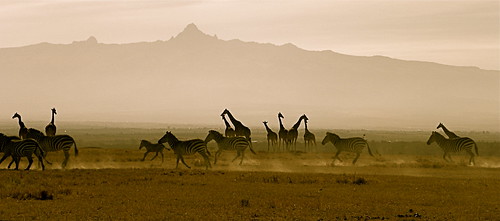世界自然保育聯盟(IUCN)14日在雪梨世界保護區大會上首度發表「保護區綠色名錄」(Green List of Protected Areas)。世界保護區大會每10年一屆,由IUCN主辦,集結全球數千位代表前來,一同為保育全世界消失中的淨土研商策略。
IUCN公布「綠色名錄」 盼保護區管理再進步
與過去權威性的的「瀕危物種紅色名錄」(Red List of Threatened Species)相比,IUCN新的綠色名錄非關物種,而是目前唯一的保護區全球表現優異名單,目的在於表揚和鼓勵優質的自然地區管理。
「綠色名錄上的保護區通過一連串嚴苛的審查,例如自然價值的品質維護。保護區還必須公平透明地分享保育的成本和效益、有效管理並展現長期保育成果。這些標準依各國面臨的機會和挑戰有不同的評估方式。」IUCN總幹事Julia Marton-Lefèvre說。
「聯合國環境規劃署13日在雪梨發表的《受保護的地球》報告顯示,全球保護區治理和管理的品質還有許多進步空間。綠色名錄將幫助全球保護區社群確實能嘉惠人民、經濟和環境。」IUCN綠色名錄經理James Hardcastle說。
管理方式因地制宜 亞洲保護區韓、中入選
首次發表的綠色名錄涵蓋了澳洲、韓國、中國、義大利、法國、西班牙、肯亞和哥倫比亞的保護區。在澳洲,國家公園和野生動物管理局所管轄的3處保育區入選IUCN綠色名錄。
「澳洲拜倫角州立保護區因地方社群積極參與保育而入選。2001年這裡能設立國家公園,Arakwal原住民貢獻良多並且全程參與每日的管理。」Hardcastle說。
肯亞Ol Pejeta保育區則是少數准許經營牧場的保護區,以社群養牛計畫具有監控和保護功能,並提供家畜健康服務,保護野生動物和家畜,確保當地牧民有豐富的牧草地。
法國Cerbère-Banyuls自然海洋保護區自1974年設立以來,成功復育海洋物種和脆弱海洋棲地。由導遊帶領遊客觀賞的的教育性水下野生動物園,是當地最熱門的景點之一。
《受保護的地球》報告指出,全球正往2020保護區擴張目標邁進,但要確保重要地區生物多樣性和生態系統服務受到公平的管理和保護,仍有許多待辦事項。
國際野生生物保護學會(WCS)氣候變遷計劃主任在公園大會致詞時整理了全球保護區網路的成功、挑戰和更大規模保育佈局的需求:「我們需要社會、財務和政治的介入,各階級的政府和產業至少必須對保育持中性態度,最好能積極支持保育工作。」
The IUCN’s Green List of Protected Areas was introduced to the world today at the IUCN World Parks Congress 2014 in Sydney. Held once every 10 years by the International Union for the Conservation of Nature, the World Parks Congress gathers thousands of delegates from around the world to strategize on protection of the planet’s vanishing pristine areas.
Protected areas in Australia, South Korea, China, Italy, France, Spain, Kenya and Colombia were unveiled as the first to be listed at the official announcement as part of the innovative Green List of Protected Areas project developed by the IUCN.
The Green List parallels the IUCN’s authoritative Red List of Threatened Species as a resource for planetary protection.
The Green List of Protected Areas is the only global standard of good practice for protected areas and it aims to recognise and promote success in managing some of the most valuable natural areas on the planet.
“The sites have been evaluated against a set of demanding criteria, including the quality of protection of natural values. They should demonstrate fair and transparent sharing of the costs and benefits of conservation, effective management and long-lasting conservation outcomes. These criteria are tailored and measured according to the challenges and opportunities faced in each country,” said Julia Marton-Lefèvre, IUCN Director General at the launch.
“The ‘Protected Planet’ report launched yesterday in Sydney revealed that much more needs to be done to improve the quality of governance and management of global protected areas,” said James Hardcastle, manager of the IUCN Green List of Protected Areas.
“The Green List will help the global protected area community ensure that protected areas have real conservation impacts that benefit people, economy and the environment,” he said.
In Australia, three reserves managed by the National Parks and Wildlife Service have been accepted to the IUCN Green List: Arakwal National Park, Cape Byron State Conservation Area, and Montague Island Nature Reserve.
“One of the successful candidates, the Cape Byron State Conservation Area/Arakwal National Park in Australia, has been ‘green listed’ for its engagement with the local community. The Aboriginal Arakwal traditional owners were instrumental in establishing the National Park in 2001 and are fully involved in its daily management,” said Hardcastle.
In Kenya’s Ol Pejeta Conservancy, pastoral ranching is allowed within the protected area. Its management runs a community cattle ranching programme providing monitoring, protection and livestock health services, ensuring protection for both wildlife and cattle and a safe haven and rich pastures for local herders.
In France, the Cerbère-Banyuls Natural Marine Reserve has seen a successful recovery of marine species and habitats since it was established to protect fragile marine habitats in 1974. A guided underwater educational safari is one of the most popular visitor drawcards on this stretch of the Côte Vermeille, at the foothills of the Pyrenees.
The “Protected Planet” report released by the UN Environment Programme at the Congress finds that the world is on track to meet a 2020 target on the expansion of protected areas, but more work is needed to ensure areas of importance for biodiversity and ecosystem services are prioritized for protection under equitably managed conditions.
Watson, director of WCS’s Climate Change Program, outlined the successes, challenges, and need for a larger conservation vision for the world’s protected area networks in his keynote address for the Opening Parallel Plenary of the Congress’s Parks session.
“We need social, financial, and political buy-in,” he said, “and, at the very least, the various levels of government and industry to be neutral to conservation, and at best actively supporting conservation.”
※ 全文及圖片詳見:ENS





